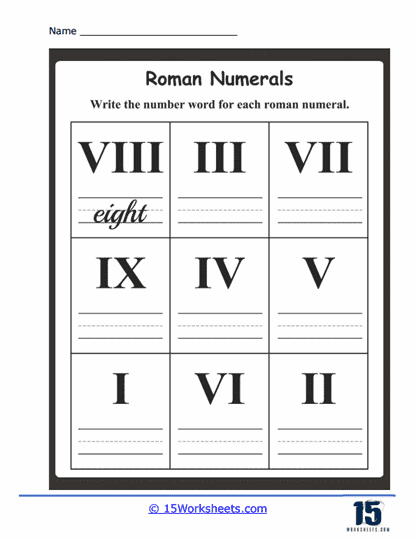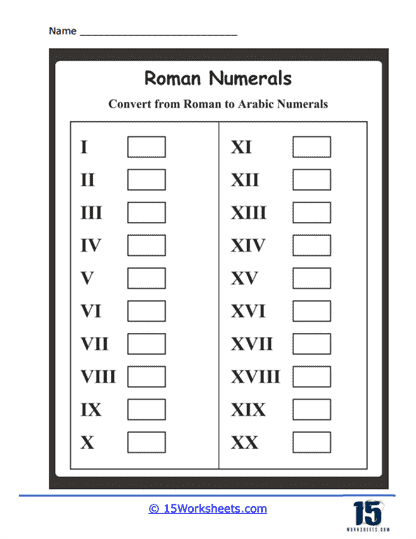Roman Numerals Worksheets
About These 15 Worksheets
These worksheets will help students understand and practice using the Roman numeral system. Roman numerals are a numeral system originating from ancient Rome, and while they are not commonly used in everyday mathematics or most modern applications, they remain a subject of interest due to their historical relevance and their occasional use in specific contexts, such as the ones mentioned earlier.
Roman numerals are based on certain letters of the alphabet which correspond to certain values:
I = 1
V = 5
X = 10
L = 50
C = 100
D = 500
M = 1000
Numbers are formed by combining these letters and are usually written largest to smallest from left to right. There are specific rules on how these numerals are to be used, especially when smaller numerals precede larger ones.
Types of Exercises on Our Roman Numeral Worksheets
1. Identification – These exercises begin with a brief history and an explanation of how Roman numerals work.
Example: Students might be presented with a series of numbers in both Roman and Arabic forms and asked to match them. For example, matching “V” with “5” or “X” with “10”.
2. Conversion (Arabic to Roman) – Students are given Arabic numbers and asked to convert them into Roman numerals.
Example: Convert the following numbers to Roman numerals: 4, 9, 15, 44, 99, 500, 1000.
Answers would be IV, IX, XV, XLIV, XCIX, D, and M respectively.
3. Conversion (Roman to Arabic) – Here, the direction is reversed. Students are given Roman numerals and must convert them to Arabic numbers.
Example: Convert the following Roman numerals to Arabic numbers: VII, XXI, L, CXL, DCCC.
Answers would be 7, 21, 50, 140, and 800 respectively.
4. Ordering and Comparing – These exercises help students understand the relative values of Roman numerals.
Example: Arrange the following Roman numerals in ascending order: V, X, I, L, C.
Answer: I, V, X, L, C.
Addition and Subtraction with Roman Numerals – While not as straightforward as with Arabic numerals, arithmetic can be done using Roman numerals.
Example: Add the following Roman numerals: X + V, XX + II. Or, subtract: XX – X, L – V.
Answers: XV, XXII, X, and XLV respectively.
Recognizing Patterns – This exercise focuses on recognizing the patterns in Roman numerals, like how IV represents 4 and IX represents 9.
Example: Identify the pattern and fill in the blanks: I, II, III, __, V.
Answer: IV.
Fill in the Blanks – These exercises provide partial information, asking students to fill in what’s missing.
Example: Fill in the missing Roman numeral: XX_ for 30.
Answer: XX(X).
These exercises range from basic identification and conversion tasks to more complex arithmetic and real-world application problems. By working through these exercises, students not only gain an appreciation for the historical significance of Roman numerals but also enhance their analytical and mathematical skills, drawing connections between the ancient and modern worlds.
When Is It Appropriate To Use Roman Numerals?
Roman numerals have mostly fallen out of everyday use in favor of the more versatile Arabic numeral system. However, they still have a number of specialized or traditional applications in the modern world. Here are some instances where it’s appropriate to use Roman numerals:
Clock Faces – Traditional analog clock faces often use Roman numerals for the hours, especially in more classical or ornate designs.
Film and Television – Roman numerals are often used to denote the production year in film and television credits, especially at the end of movies.
Book Chapters and Volumes – Some publications, especially in formal or classical works, use Roman numerals to number chapters, volumes, or book parts.
Generational Names – In names, Roman numerals are sometimes used to distinguish between members of a family with the same name, like John Smith I, John Smith II, etc.
Outlining – They can be used in the creation of an outline, where main topics might be designated with Roman numerals, sub-topics with capital letters, and so on.
Monarchs and Popes – Kings, queens, and popes with the same name are differentiated by using Roman numerals, such as Queen Elizabeth II or Pope John Paul II.
Events – Recurring events, especially those with a long history, might be numbered using Roman numerals. The Super Bowl is a well-known example, with each year’s game receiving a new Roman numeral.
Tattoos – Some people choose to have Roman numerals tattooed on their bodies, often representing significant dates or numbers.
Legal Documents – Some legal documents or formal protocols use Roman numerals for their section headings.
Historical Context – When discussing periods in history, particularly when referencing Roman history itself, using Roman numerals can be both appropriate and atmospheric.
Architecture and Art – Descriptions or naming of architectural features, or in art titles and inscriptions, might utilize Roman numerals for a classical touch.
Special Editions of Products – Sometimes, products (like watches, books, or luxury items) might feature Roman numerals in their naming or design, signaling a special or limited edition.
While Roman numerals are not as functionally efficient as Arabic numerals for most modern applications, they carry a sense of tradition, formality, or aesthetic appeal that can make them appropriate for certain contexts.















